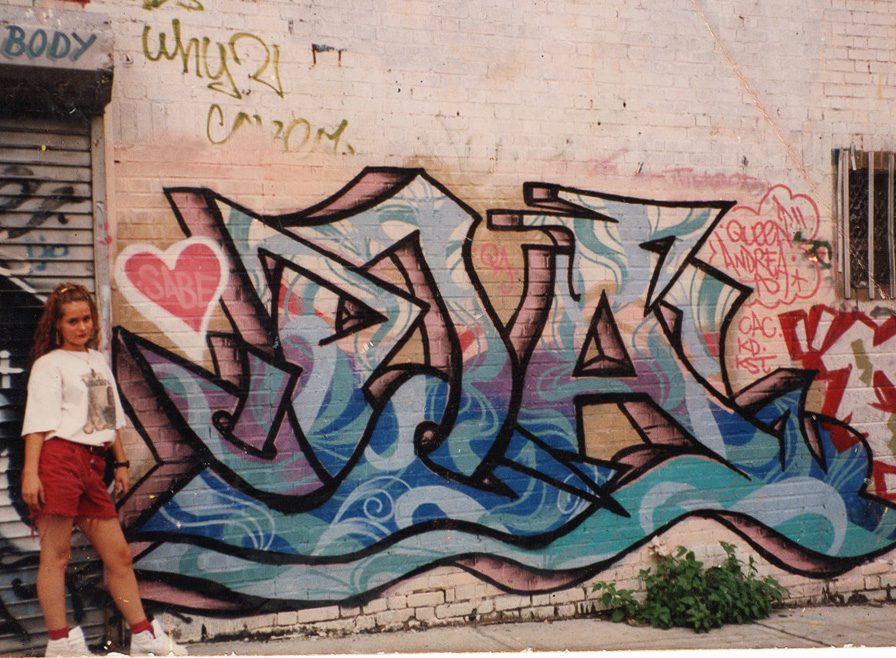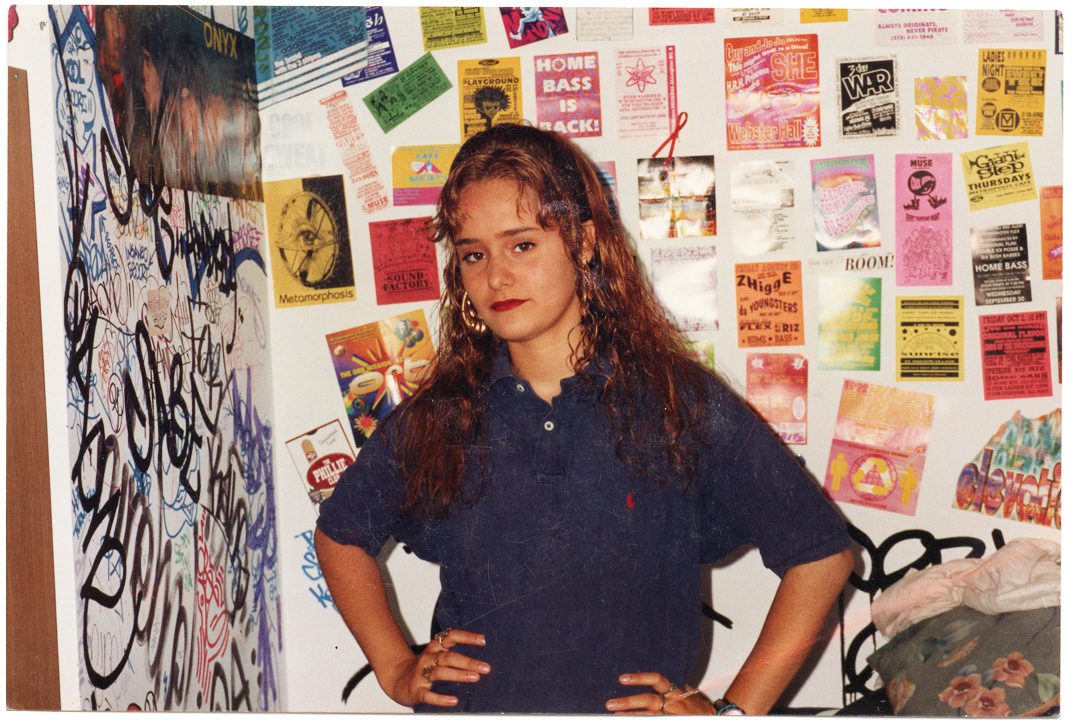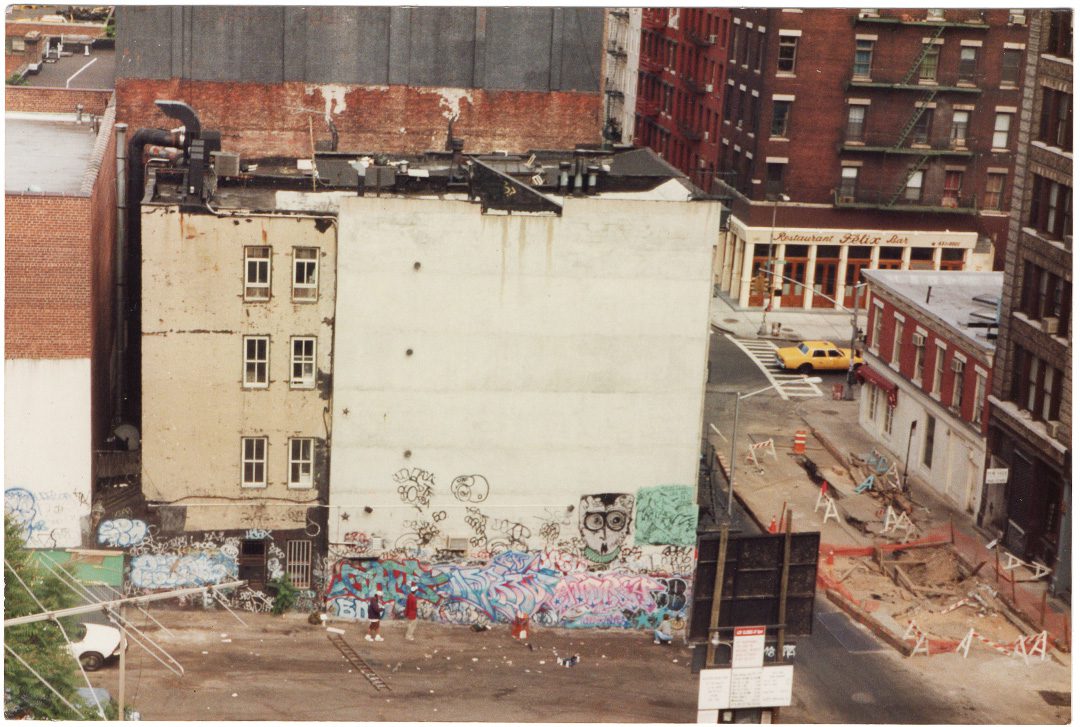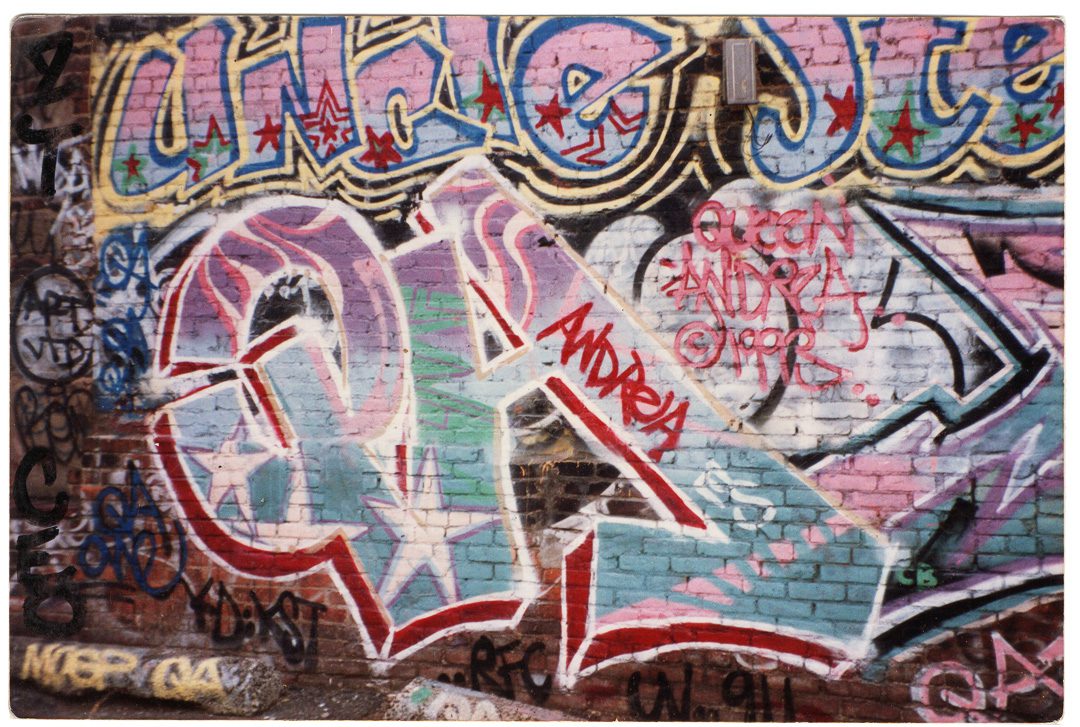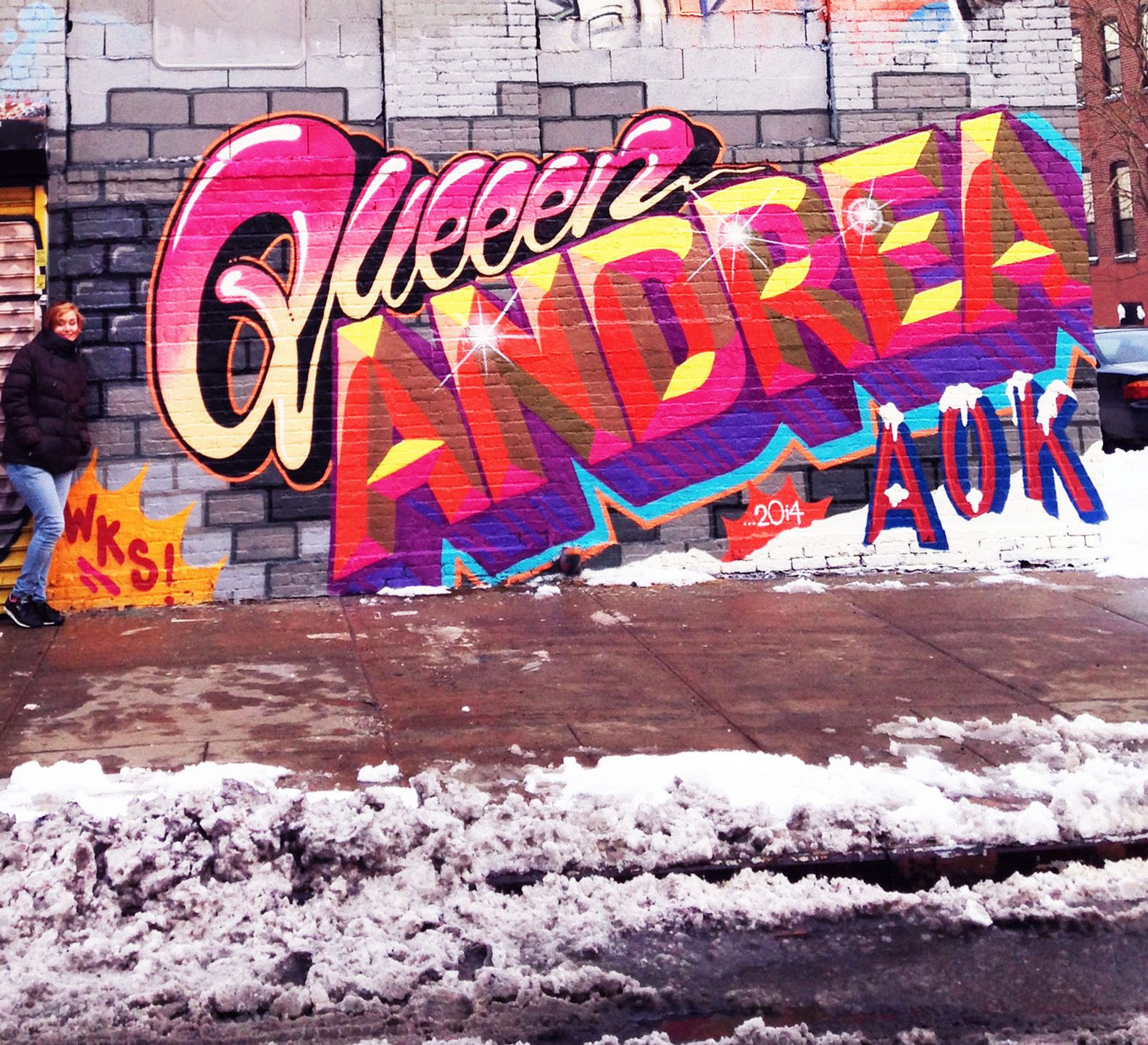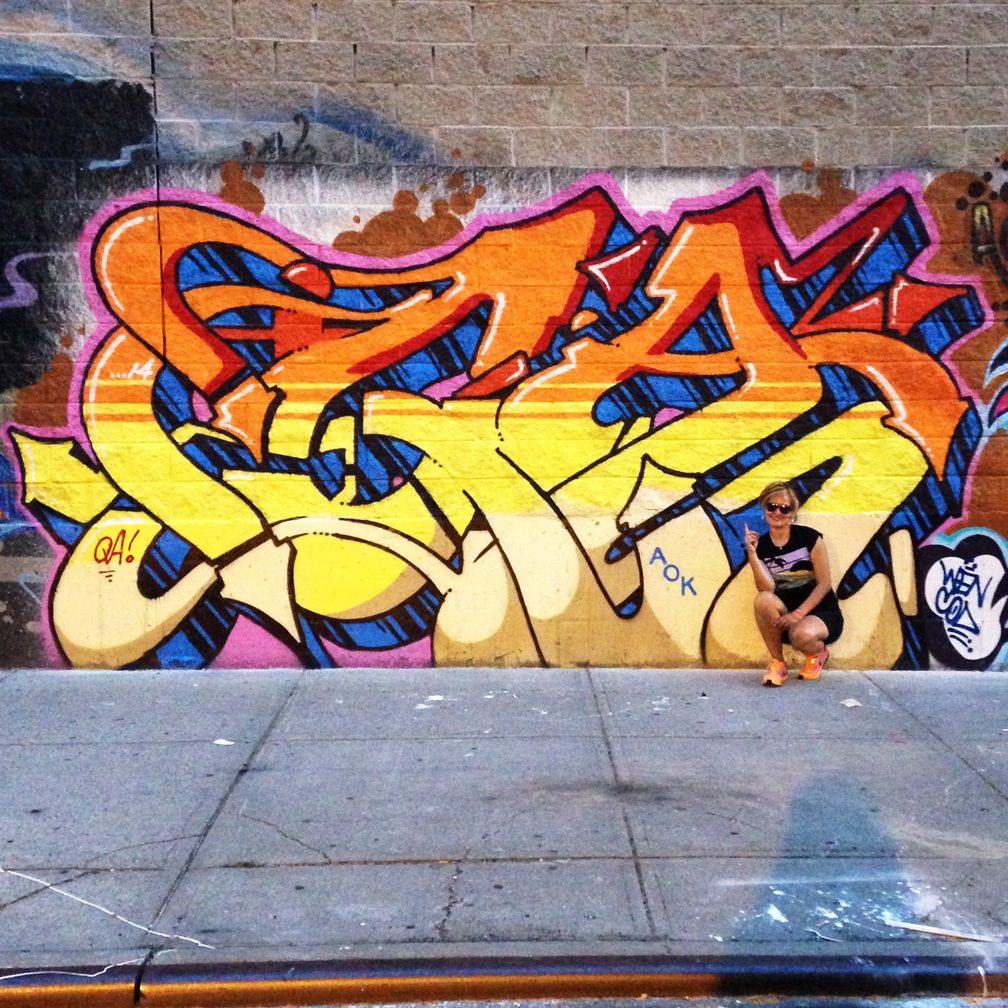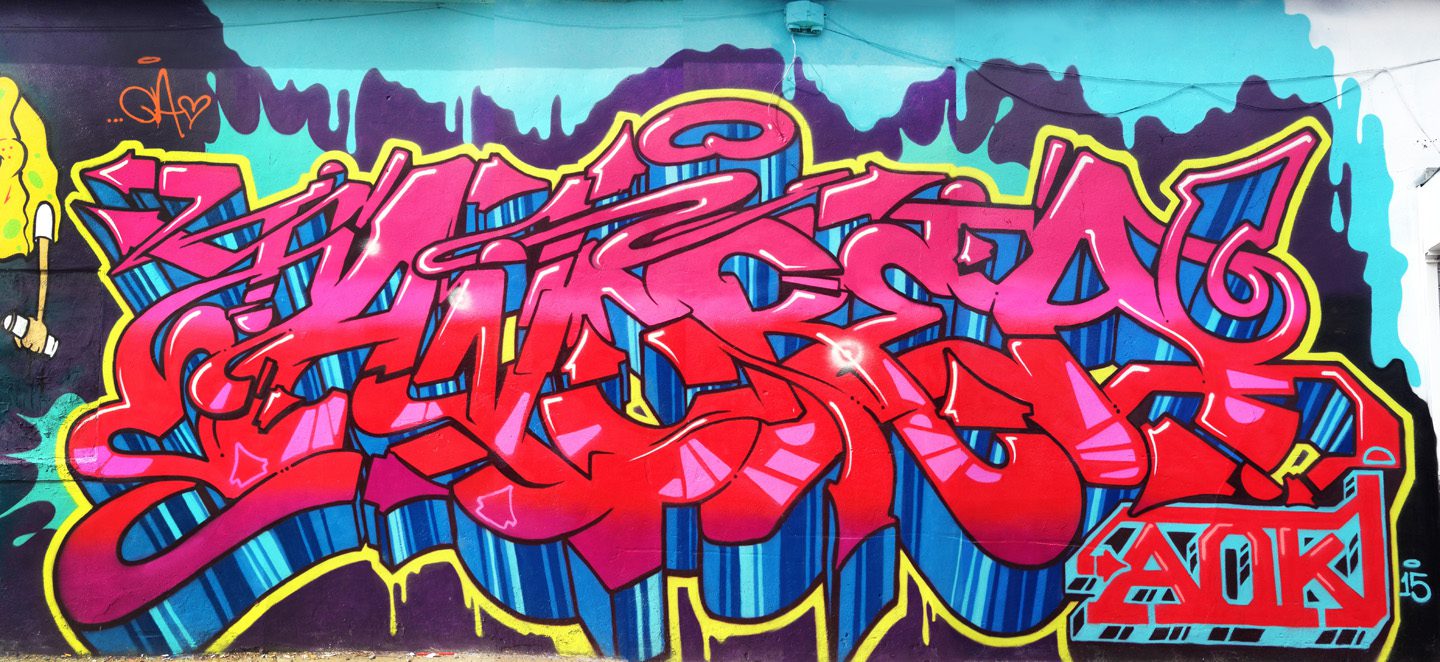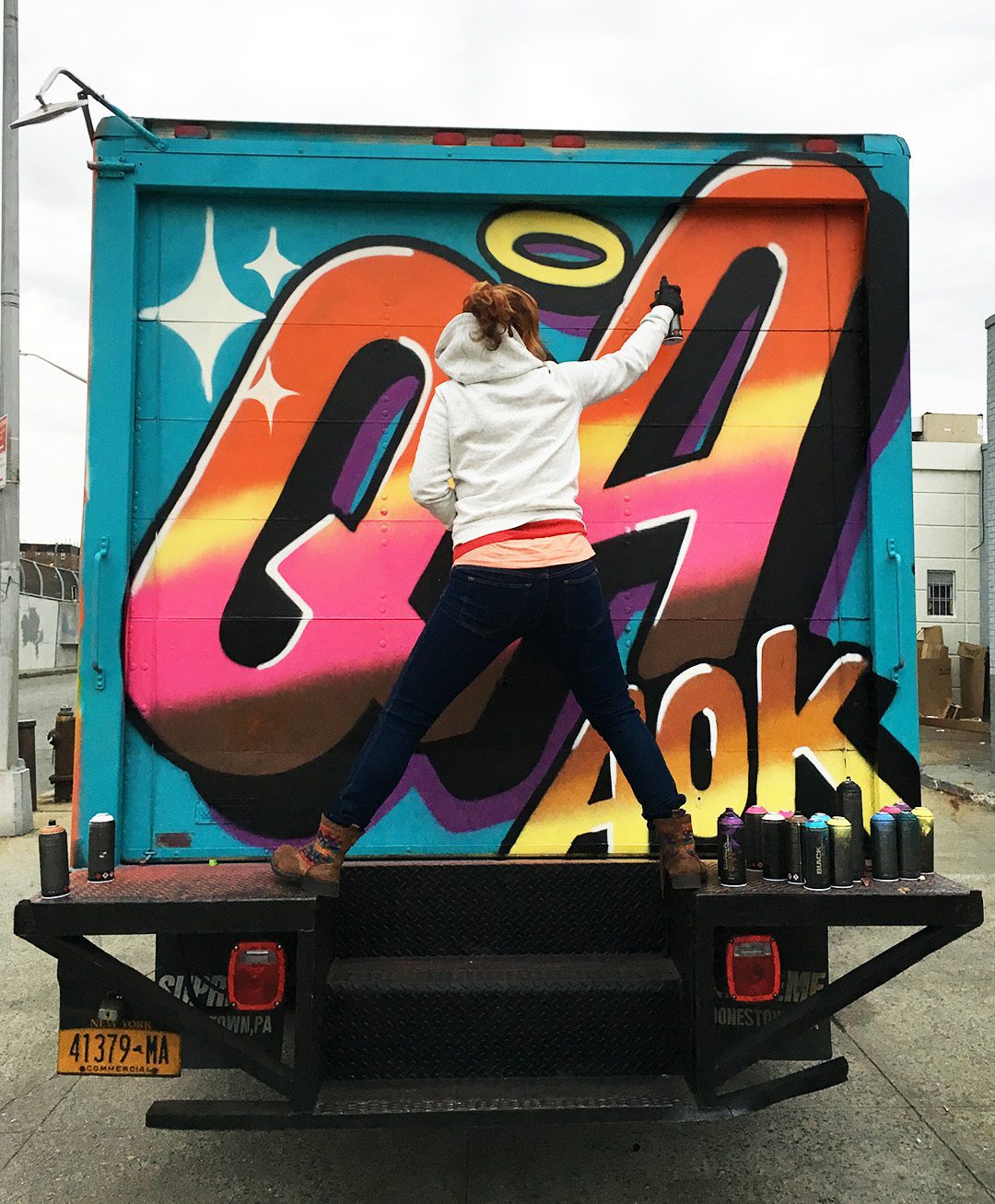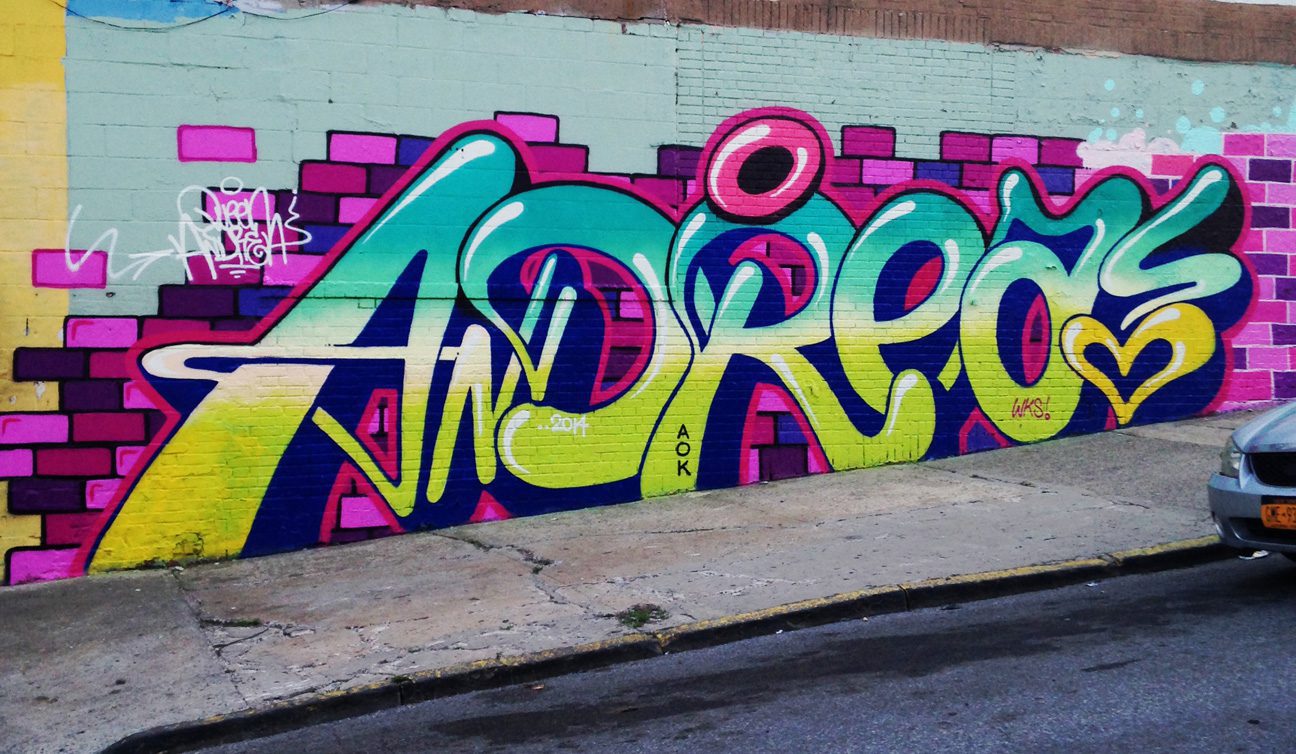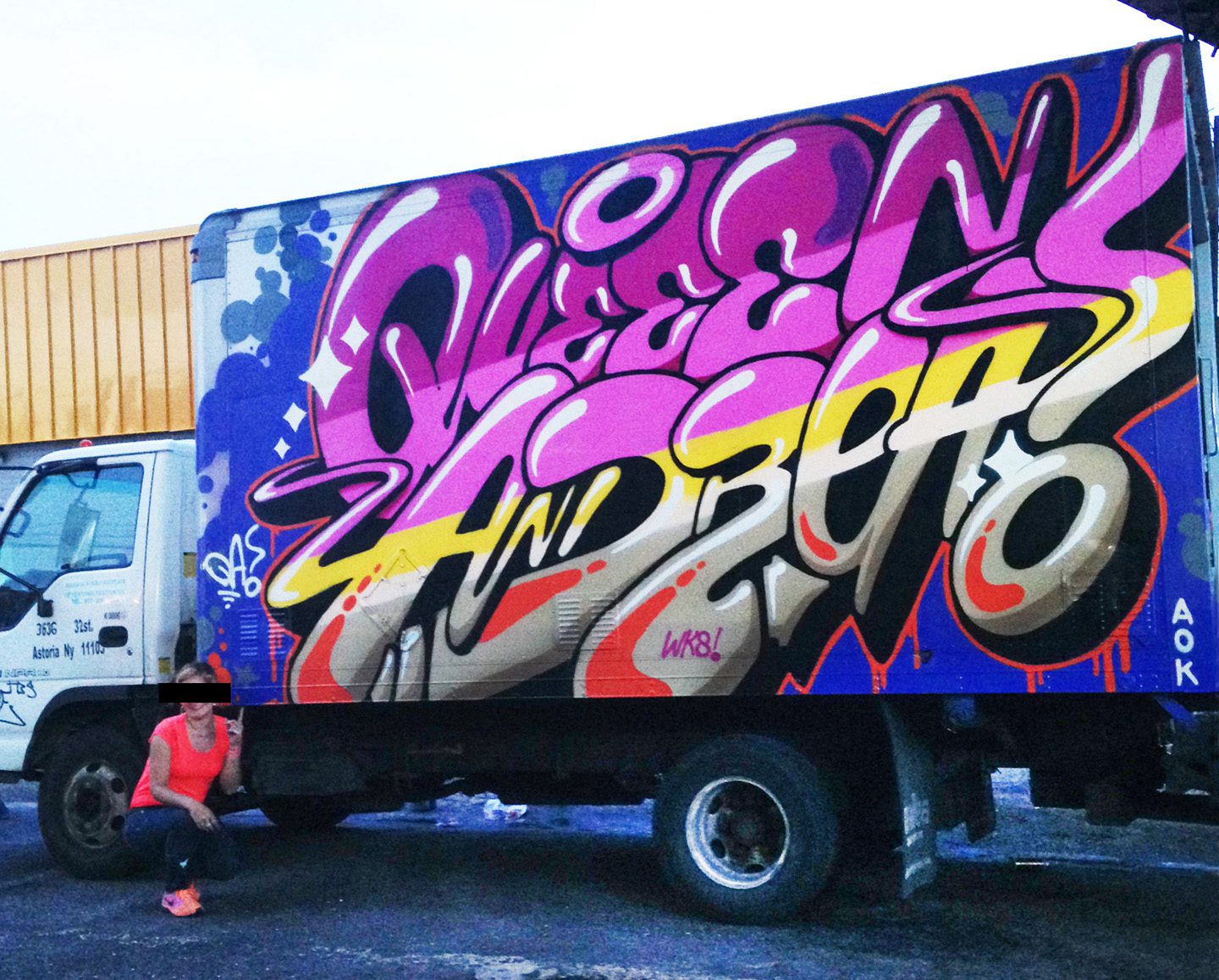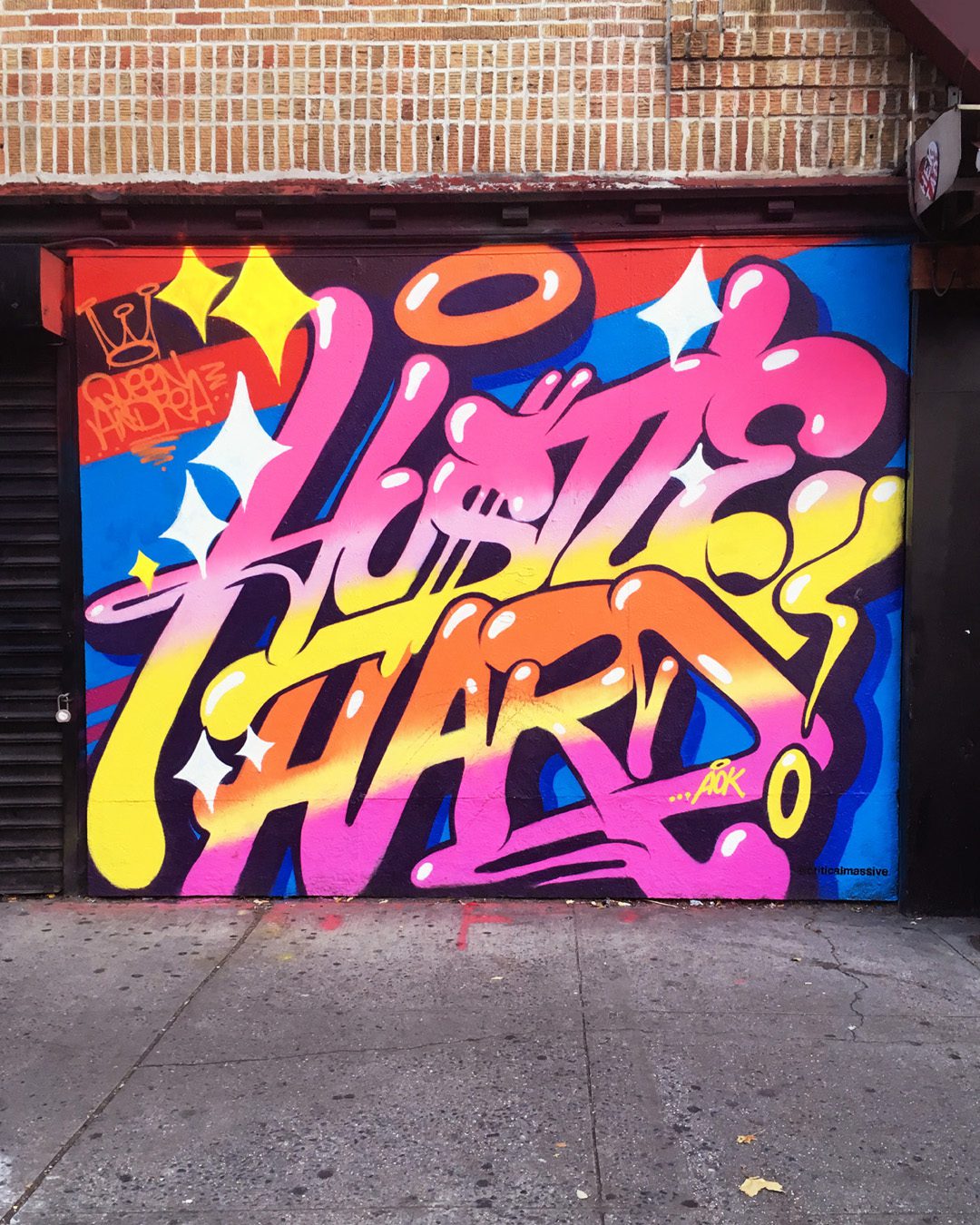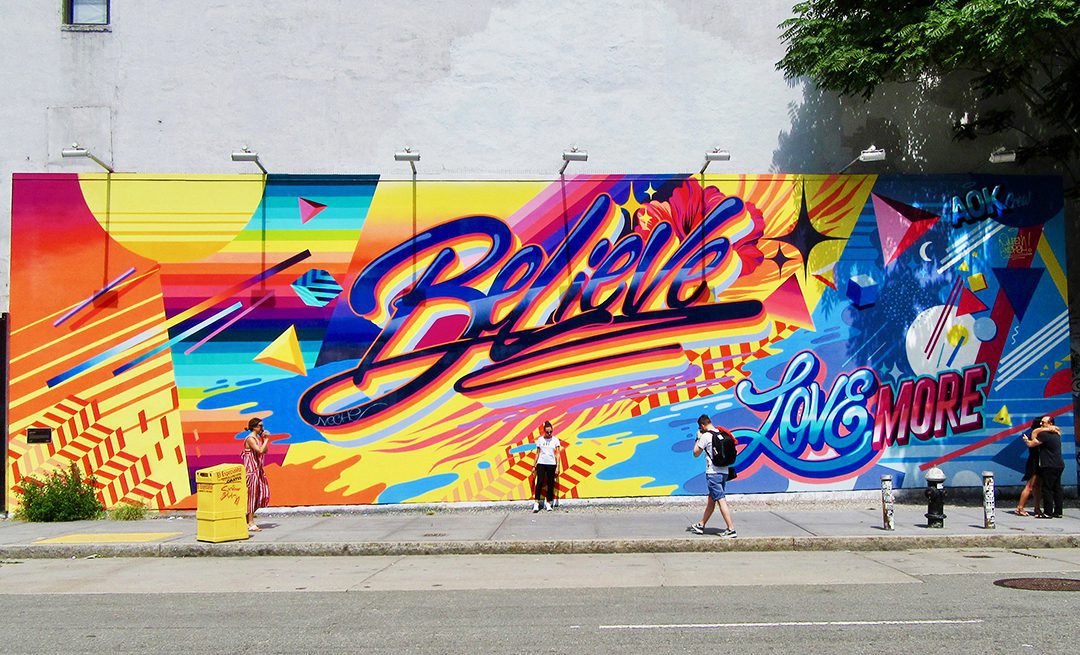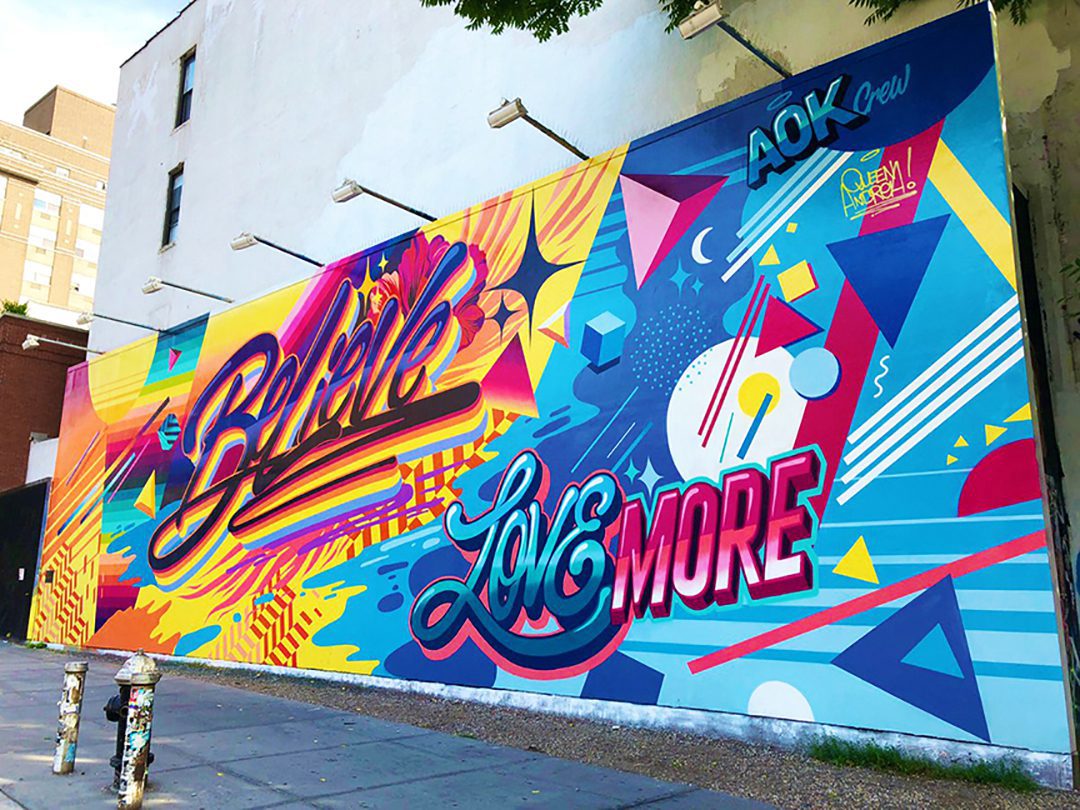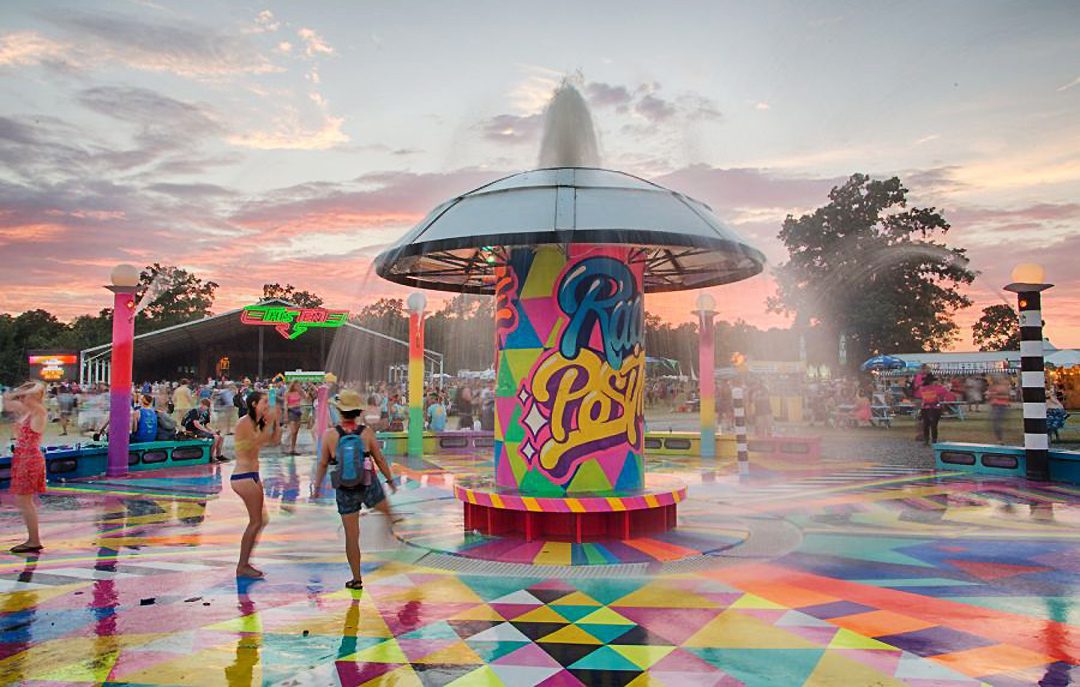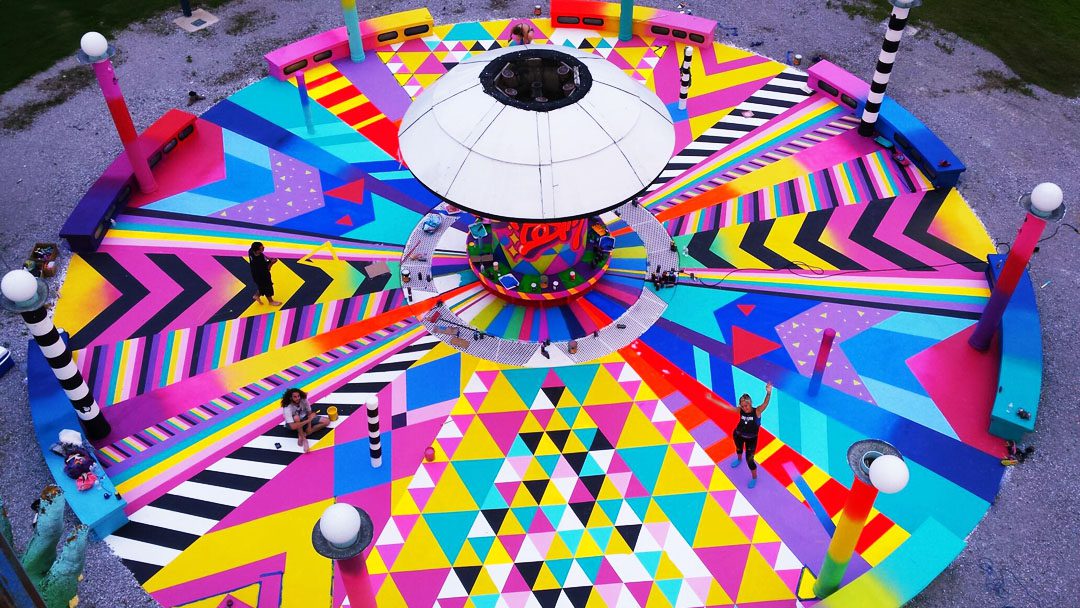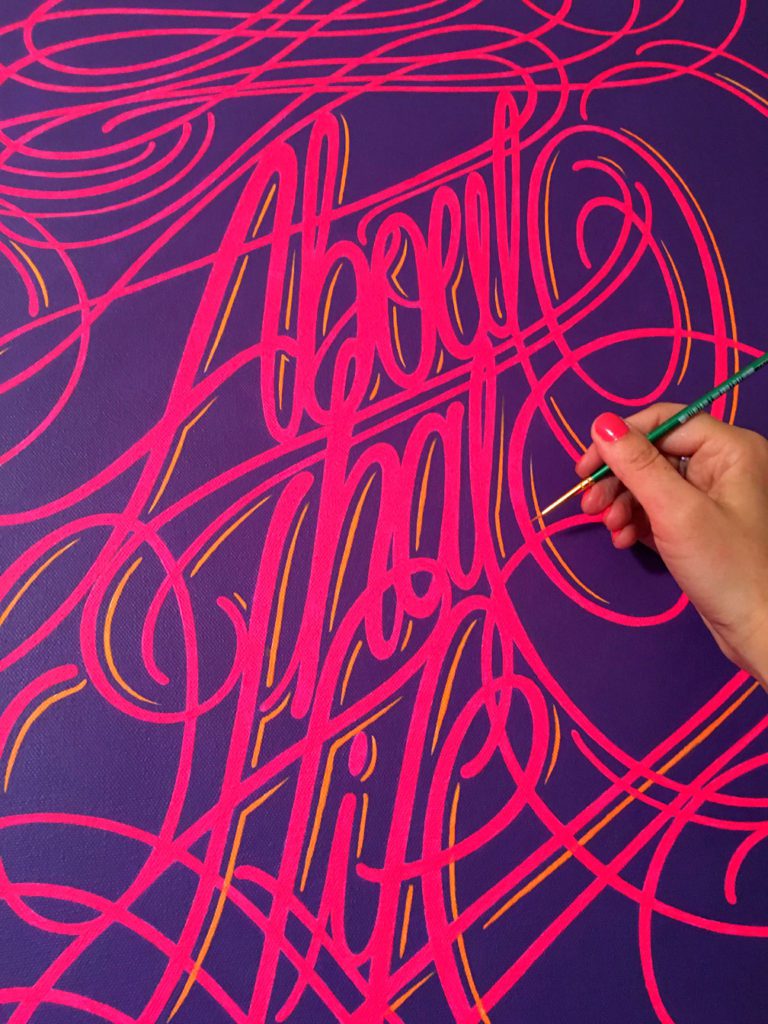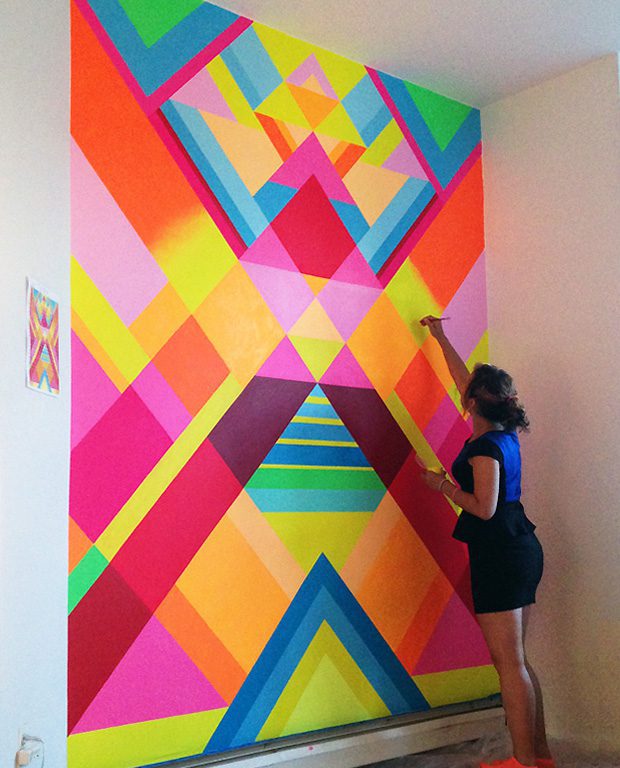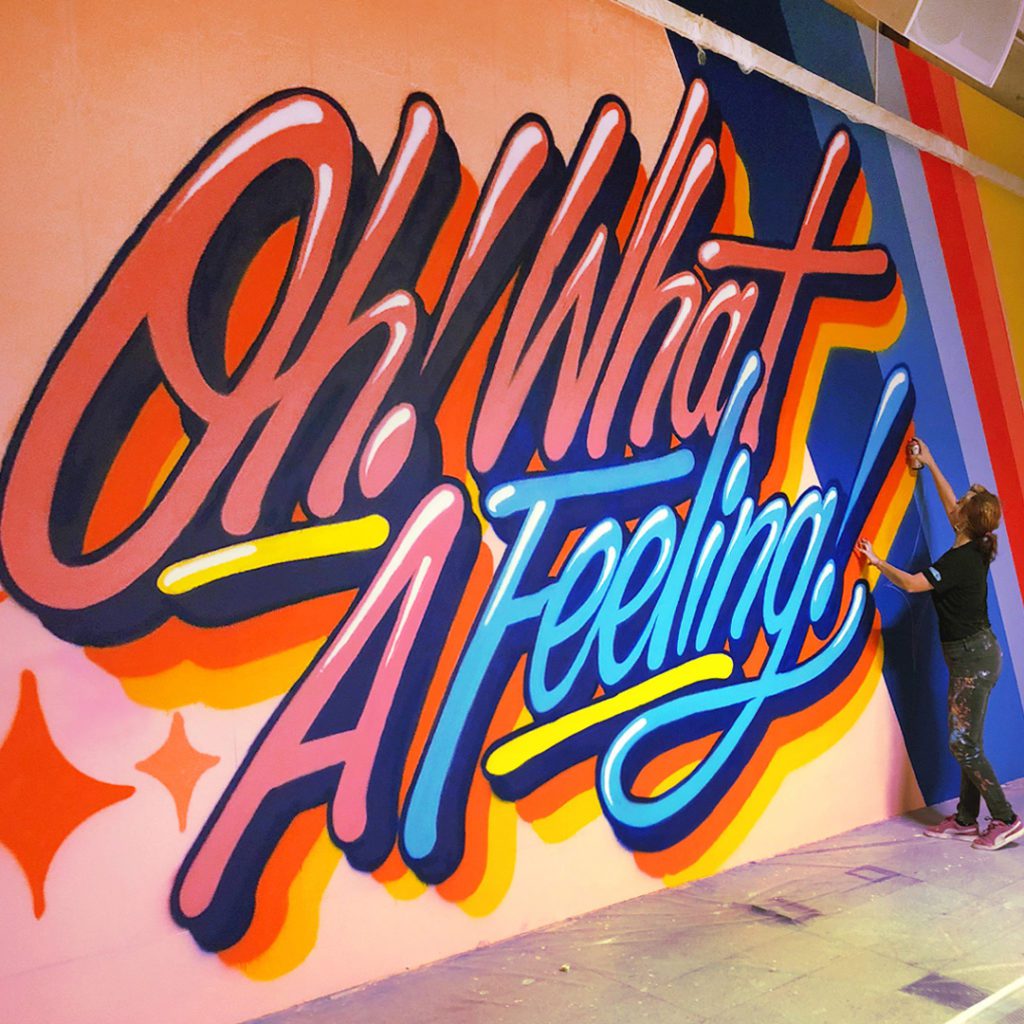The 90’s decade was the hip hop and urban culture Golden Age in New York but also the end of the ‘subway graffiti’ era, which in a natural way, gave birth to the bombing of the streets in the City by the graffiti writers and the establishment of some of these prolific train artist in galleries that were measuring the temperature of the streets.
Andrea von Bujdoss aka Queen Andrea (New York) grew up in the Soho area in the middle of this spirited mix and with Manhattan’s vibrant energy outside her doorstep. She explored the streets and became a dedicated writer pushing forward to step into an all-boys club. After a few years she changed the rough, though exciting lifestyle of vandalism to get creative in the exploration of letters, uplifting colors and messages that today she develops in her mural artwork in the streets but also as a graphic designer and in her studio work.
In February we shared with her a few days in Madrid for Urvanity Art 2020, where she created an immersive and colorful space inside the fair and participated exhibiting her work at McCaig-Welles Gallery booth. We catch up on a phone call to talk about New York’s graffiti early days, women in the profession and her work as a prolific artist, master of color and style. ‘Hustle hard’, she says.
How was it to be raised in Downtown Manhattan during the 90’s decade? By that time there was a massive urban culture scene going on in New York…
That area was very vibrant, there were so many things happening, a lot of street art, vandalism tagging everywhere, a lot of clubs, amazing music… It was really the golden era of Hip Hop at that time! It was the beginning of street wear, there was punk music, skateboarding, raves, electronic and dance music… It was really an amazing time, everything was just in full-swing at that time and it was a great place to grow up.
Queen Andrea in her room, 1994
QA on the Lucky Strike Wall, 1994
The 90’s were also the end of the subway graffiti era with the last painted car running on 1989 after the Metropolitan Transportation Authority (MTA) and New York City Transit Authority (NYCTA) won the war against graffiti writers. But this also became the beginning of a new era, graffiti moved into the streets…
At that time people were figuring out: If we can’t paint trains now, what do we do? That’s how street bombing happened, and creating a new culture around the streets. Every aspect of graffiti has rules and painting a train is different from painting in the street so all of that was getting established by that time. It was a pretty amazing time in the City ‘cause there was so much more of it than there is now. Nowadays there’s a lot more investment in Real Estate and landlords want to keep the buildings clean… Graffiti wasn’t even a felony until the mid-90’s so there was just graffiti everywhere, I thought it was beautiful. They were writers doing outrageous things, huge ‘throwies’, just writing their names, bubble letters really tall, like 8 feet tall on Avenues that were really busy…
How was the law (or outlaw) of the street back then?
Within the culture you had to present yourself into a certain way so that you get respect and are able to be friends with the right people. You need to know how to handle yourself if there’s beefs or if people don’t like you. Graffiti is really territorial. A lot of times it’s about the spots, if someone comes and goes over your piece then you create a war, “that is my wall, my territory”. Sometimes people go over each other because there’s a fight elsewhere and they take it into the graffiti world, so they go over that person, and over their friends… Then two crews are fighting and all this process of tagging over each other in the street… There was a lot of that in the 90’s. There’s not as much now and it’s interesting because we all have sort of grown up which is nice, and there is sometimes beef here and there but it’s not as wild as when the taking off of the culture. In the early 2000, when more of these artists became established in gallery settings or with advertising campaigns we all started to chill out a little bit and collaborate, some of the writers are very accomplished and we all celebrate it together.
How was Queen Andrea in her teenage years moving inside the graffiti world?
It was around that time, in the late 80’s early 90’s, when I was still going to school and I was about 12-13 years old, that I started to have an interest in graffiti and the things that were going on in the street. At age 15 I was trying to figure out how to be a better graffiti artist. I was so inspired by some of the early graffiti writers from the 1980’s and I was lucky to make friends in my neighborhood with people like that. One of my best friends at the time was Alan Ket, [today he’s one of the Museum of Graffiti founders that opened in Miami in 2019]. He had this photo album of graffiti from back in the days, he was really into archiving even back then, and so he would show me the photo album from subway trains painted. Even from the 70’s and 80’s, and I was able to get this knowledge and education about graffiti art. I had a lot of those influences and it was just great being active during that time. I would go paint all night in these crazy places, breaking and trespassing, doing all types of crazy things that graffiti writers do. It was really interesting, I loved being a part of it, it’s a daring and risky outlaw sort of thing to do. It was fascinating for me, very exciting!
QA in Canal Street, 1993
QA in the Bronx, 1994
Did you had any mentors in graffiti?
Not really, I had people that would help me with the QA outlines, do them for me… But not really a dedicated mentor. I really was self-taught through the entire process of learning my letters and becoming a better graffiti writer. That was just hours in my bedroom practicing, figuring out the structures, how to balance the letters, create new ones and ultimately have to paint them in the street. Which by the way is a whole other thing, one thing is to have some style on black books and another to be able to take it into a wall. I learned can control, designs inside my letters, outlines, keeping my hand steady… What I did have was great inspiration from the early days writers like Seen, Blade, Dondi, Wade, T-Kid… They were doing subways and were very, very talented. In the movie “Style Wars” there are a few writers like Seen, Kase 2 or Skeme, who really were amazing during those eras. We always had people to look up to, but still for every writer you need to learn it on your own and have your own style.
Being a women in this scene was sadly a pretty rare thing to see… Did you get any support from any other of the writers or belonged to a crew that protected you somehow?
I did have some friends and support early on. AOK was one of the earliest crews I was involved with. These guys were a lot of them painting on the subway trains in the 80’s and were very skilled style writers. It was great to be included with them because they were not only great in what they did but very experienced. I could be with them, hang out, I was accepted so that was very important. There were other crews like RFC which is a very important one to the downtown scene in Manhattan. In graffiti you need to establish your loyalty to a certain crew and know how to handle yourself, give respect to get respect.
Queen Andrea piece winter 2014 with AOK crew signs
Queen Andrea, 2014
Andrea piece in Jersey City, 2015
Did you find any restrictions for being a woman?
I did in a sense that it tends to be an all-boys club and I think for women there’s still not that equality, so sometimes I wasn’t always included just because I was a girl. It was like being an unicorn in that setting. People couldn’t believe there was actually a girl wanting to paint on the same wall. The thing was that I was so interested in what I was doing that if people would say things to me I would push even harder. There were other aspects of the culture that made me feel strong about that: I loved the music, the fashion, I did skateboarding for a while, I was learning how to breakdance… Actually breakdancing is very hard! They were other aspects of the culture that really kept me going, it wasn’t just being accepted by the boys, I was just pushing forward and enjoying myself.
Where there any other women who you were sharing the scene with? Another huge feminine reference in graffiti from the 80’s in New York was Lady Pink, was she a role model to you?
I was 15 when I met Lady Pink and she was already quite established. She came from the subway train era and I was star-strucked. She painted huge murals at that point, different pieces around the city, also canvases… Later in the 90’s they were doing these productions that were just out of this world including portraiture, landscapes, totally wild letters… She was not only an inspiration because she pushed ahead and didn’t’ really cared about what people was saying because she was a female, but she also pushed ahead with the styles and she was doing things in the early 90’s that I couldn’t even imagine approaching. She’s a very strong woman and her personality inspired me a lot. I also had a friend from my neighborhood named Gillian who was my age and we did a lot of things locally, but besides that there weren’t many other females in New York doing graffiti.
QA on a truck, 2015
Bronx, 2014
Astoria, 2014
After a while you started exploring new colors, shapes, letters… And started becoming a prolific style master. Was it an important turning point for you when you started introducing quotes and phrases in your work instead of just your name?
The street was kind of a rough lifestyle, so I decided to try something else where I would get creative and explore colors and letter forms… Somehow become a master of letters. It was about eight years ago that I started with the messages. Overtime I got a little bored of just doing my name and I wanted to start doing different phrases. I decided to try something new, challenge myself a bit more and figure out how to paint different phrases that wasn’t just the two words of my name but it could be up to ten words. How do I fit all of that in this one space I have in the wall? I love hip hop and for me this was a way of writing lyrics that are related to the urban culture or to everyday hustle that we do in life in these urban cities. I wanted to put that message out. Also I haven’t seen a lot of people doing it so I thought it would be really exciting.
Which message represents you the best?
In terms of graffiti ‘Hustle Hard’ I will definitely say is the one that represents me the most. Also ‘Love Wins’ just because life in general, also in graffiti, is not always very fair and people can be aggressive for no reason. It’s important to realize that in the end love wins and it’s part of a good mantra for me for life.
‘Hustle Hard’ for Outlaw Arts Commission, NYC
Work in progress of ‘Love Wins’ for Smirnoff
What is your most important piece of all times?
Probably the Houston Bowery Wall. That was not even a year ago when I did it, but the ‘Believe’ wall is so important to me because I grew up at that neighborhood and the wall itself is totally legendary. Keith Haring painted it in 1982, and some of the best artists have been on that wall. Also the message was important for me, writing ‘Believe’ at that size was a call to action for people to have strong beliefs about their life and act on them. Use that as a way to empower yourself. I have some other favorite from back in the early 2000’s, that was when I started to paint more in the street after graduating from college in 2001.
‘Believe’ on Houston Bowery Wall, 2019
‘Believe’ close up on Houston Bowery Wall, 2019
In the meanwhile you were studying a BFA in Communications and Design and developed a career in graphic design working in different companies. How did you move in between these two worlds?
So graffiti is great and fun, but through all of this that I was saying, I also needed to have a job. Most graffiti writers even in the 80s and 90s had some type of job as well, unless they got really well-known and were already selling artworks. I went through a lot of different jobs and I was able to start mixing my knowledge of urban culture with something more corporate. In Mass Appeal Magazine I was designing the entire magazine, working with photographers and illustrators and it was about graffiti, urban fashion and lifestyle. I continued going in that direction and worked with brands that were corporate but also urban, designing urban fashion clothes, working in advertising… I was able to blend the two worlds in a way that was still genuine, not just selling out. I was working with Art Directors who themselves were former graffiti writers.
Did the idea of ‘selling out’ worried you?
It really is an important topic this one, there still is a conversation. Sometimes people say “all of these belongs in the street and it shouldn’t be monetize”, and other people think “well, it could be documented…”. The thing is that it just keeps growing because companies and the mainstream media thinks it’s very cool, which it is and always has been… So it’s a fine line though, doing that commercial work but staying genuine to your own roots and not sharing too much or at least sharing it with companies that appreciate the culture. Now I just work on my own, I’m a working artist and people come to me for that urban style and also just to feature my work in campaigns. It’s a way for me to bring that knowledge of urban culture, but also do something brand new with it.
Bonnaroo Music Festival fountain, 2015
Bonnaroo Music Festival , 2015
Williamsburg, Brooklyn asphalt plaza mural for the City of New York
So we talked about graffiti and muralism, graphic design and advertising, but there’s a very important third leg to all of this which is your studio work.
Exactly! Actually some of the studio works I do are not related to graffiti at all. Some of it is obviously related to typography and lettering, communication style with phrases… They’re very intricate and you can’t really see the connection to graffiti but you do see a very dynamic and bombastic loud expression coming from it which is similar to my graffiti style or even personality. It freezes me off to try different things at the studio and explore typography that is not related to graffiti. I’m already obsessed with letters because I started early on and now I can do it on a more graphic design ground. Sometimes I get so busy in the street doing murals and these large scale works that being in the studio takes the backseat. In the future I want to continue focusing more in the studio works, it’s really satisfying to take the time, contemplate…
Last time we saw each other was last February in Madrid for Urvanity Art 2020 and you had a couple of projects going on back in the US. Some mural works, also a project at McCaig-Welles Gallery’s new space, even a trip back to Spain for a commission with Fundación María Cristina Masaveu… What happened to all of that?
Everything went on pause. Specially returning to Madrid were I will be working with the Fundación María Cristina Masaveu doing a permanent installation. They have a section dedicated to street art and it’s amazing to be part of it, they have Banksy, Vihls… They purchased one of my works exposed at Urvanity Art. For the moment that one is postponed, much as my other projects. But I’m happy some new projects have started. Now I’m working doing these uplifting paints on the boarded up business of some of the stores that have been closed in Manhattan. These are perfect canvases and this mural campaign is going to transform them into something colorful. It’s lively, it’s about hope, about New Yorkers and about getting through this together. Of course there will be some other large scale murals coming up later in the summer!
‘About that life’ detail
Private commission, 2014
Urvanity Art 2020 wall

